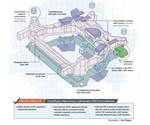CFRP use expanded in Porsche 911 GT3
Bigger than its predecessor, but with only a slight increase in mass thanks to light weight body panels.

The 2022 Porsche 911 GT3 has a top speed of 197 mph. Photo Credit: Porsche
Although the seventh generation of the Porsche 911 GT3 has an increased front track of 1.9 inches compared with its predecessor, the curb weight of the 2022 model is still a light 3,157 pounds, and only slightly heavier (4 pounds) than the previous generation (3,153 pounds). That weight increase would have been much greater if the company had not made more extensive use of carbon fiber-reinforced plastics (CFRP) in the vehicle.
The hood, rear wing, and fixed wing are all CFRP. A carbon fiber roof is optional, as are carbon fiber mirror caps. Another weight-saving option are full carbon seats: Compared to the standard seats in the 911 GT3, the composite seats represent a 26-pound mass reduction.
The 2022 Porsche 911 GT3, which is to become available in the U.S. in the fall, is fitted with a 502-horse power, 4.0-liter engine that propels the car from 0 to 60 miles per hour in 3.2 seconds. Top speed: 197 miles per hour.
Related Content
-
Bio-based acrylonitrile for carbon fiber manufacture
The quest for a sustainable source of acrylonitrile for carbon fiber manufacture has made the leap from the lab to the market.
-
Cryo-compressed hydrogen, the best solution for storage and refueling stations?
Cryomotive’s CRYOGAS solution claims the highest storage density, lowest refueling cost and widest operating range without H2 losses while using one-fifth the carbon fiber required in compressed gas tanks.
-
Plant tour: Albany Engineered Composites, Rochester, N.H., U.S.
Efficient, high-quality, well-controlled composites manufacturing at volume is the mantra for this 3D weaving specialist.

.jpg;width=70;height=70;mode=crop)











